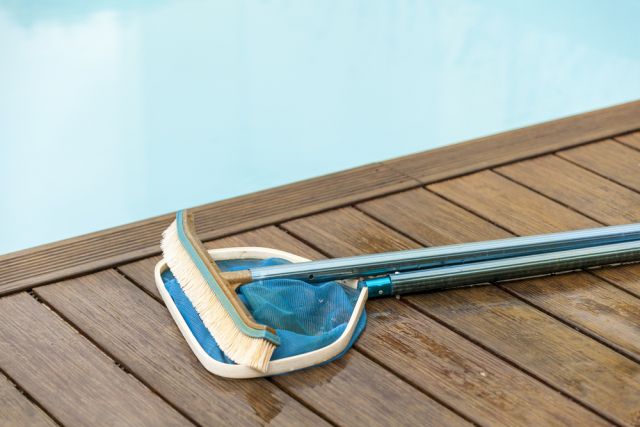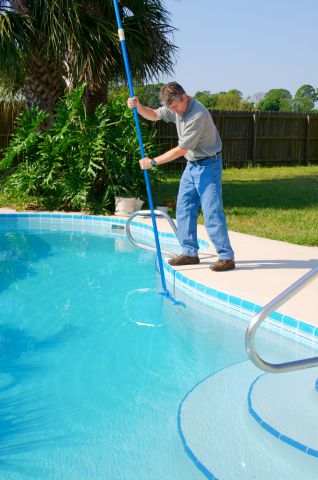One of the biggest mistake pool owners make is not paying enough attention to preparing their pool for winter. It results in irreparable damage to the pool and excess pool maintenance work in the next summer.
To avoid it, I have prepared a stepwise guide for you to close the pool for winter. Follow the guide to understand the basics of winterization of the pool, even if you’re hiring a pool service for the task.
ALSO READ: A Quick Guide To Pool Service And Maintenance in Winter
1. Clean your pool
Begin by removing all the leaves, insects, and debris from the pool by using a pool vacuum or a net. Then clean the tiles thoroughly. Many people skip the tile cleaning part and leave it for summer. But if you do it while closing the pool, you’ll need lesser scrubbing and effort in summer.
There’s a more serious reason for cleaning out the pool at this time. It prevents algae and hence, you’re less likely to deal with algae issues in summer.

2. Ensure the pool chemistry is balanced
The second step helps to reduce the corrosion of the pool during the time of non-use. You’ll need a water test kit for that. Adjust the pH, calcium level and alkalinity of the pool. The total alkalinity must be between 80-120 ppm (Figure recommended by a qualified pool service company). pH range should lie between 7.4-7.6.
Next, you need chlorination. The purpose of this step is to remove any bacteria present in the pool water. You can also use winterization kits easily available in stores. The kits contain algaecides along with chlorine to prevent bacteria and algae growth in the pool. You must follow the manufacturer’s directions while using such packages.
For chlorination, please don’t use any tablets. They may cause damage to the pool equipment. In fact, you shouldn’t even use the winterization kit directly into the pool. You should first pour the substances in the bucket and then add to the pool. Some manufacturers even require you to run the pool filter during the process. It’s all necessary to prevent damage to your pool.
3. Prevent pool damage due to freezing
As we’re already talking about how certain things can damage your pool in the winter, let me warn you of the most severe damage thread to your pool –FREEZING.
The force of frozen water is enough to damage the pool’s base and the entire equipment. At the same time, an empty pool is an even bigger risk. The soil below the pool contains water and when this water freezes, it puts a lot of pressure on the pool’s base from below. Your pool ought to have water during the winter season to tackle the pressure created by the frozen water in the soil.
To prevent the damage, pool water level must be below the skimmer mouth. Also, you should consider adding antifreeze chemicals to your pool.
You need to be careful of the water in the pipes. It should be removed.

4. Drain the pump
The pump should have no water inside it. You should disconnect the pump (and the filter as well) and then drain all the water out of it. Turn it upside down and also remove the drain plugs. Both of these steps will ensure all the water from the pump is thoroughly removed. You can run it for 1-2 seconds to expel any water that’s left behind. Store it safely afterward.
5. Clean the filter
Next step is to clean the filter. Using a filter cleaner for this purpose is a very good idea. What technique you use to clean the filter depends on the type of filter you have. For example, a sand filter can be cleaned by backwashing. If you don’t know what kind of filter you have, call a pool service to help you out. Don’t try to clean it if you don’t know the ins and outs of pool filter cleaning.
6. Cover the pool
Now, we’re done with cleaning the essential components of the pool and taking antifreeze measures. It’s time to cover the pool. If you already have a cover, check for signs of damage. If it’s ripped from several places, get a new one.
The winter cover is thicker than the summer cover as it needs strength to hold the weight of snow or ice. It also prevents pets or people from falling into the pool.
Grab a cover, spread it over the pool (always keep the black side down) and then tie it well around the perimeter. Remember to use a strong wire while doing it as you need the cover to hold still during heavy winds.
There you go! Your pool’s ready to face the winter weather. Having a pool is a huge investment, and you do not want it to get ruined due to negligence. Don’t try to cut costs or skip any steps to save some time. If you don’t know how to do it perfectly, call a pool service.
Was this post helpful to you? If yes, comment below.


